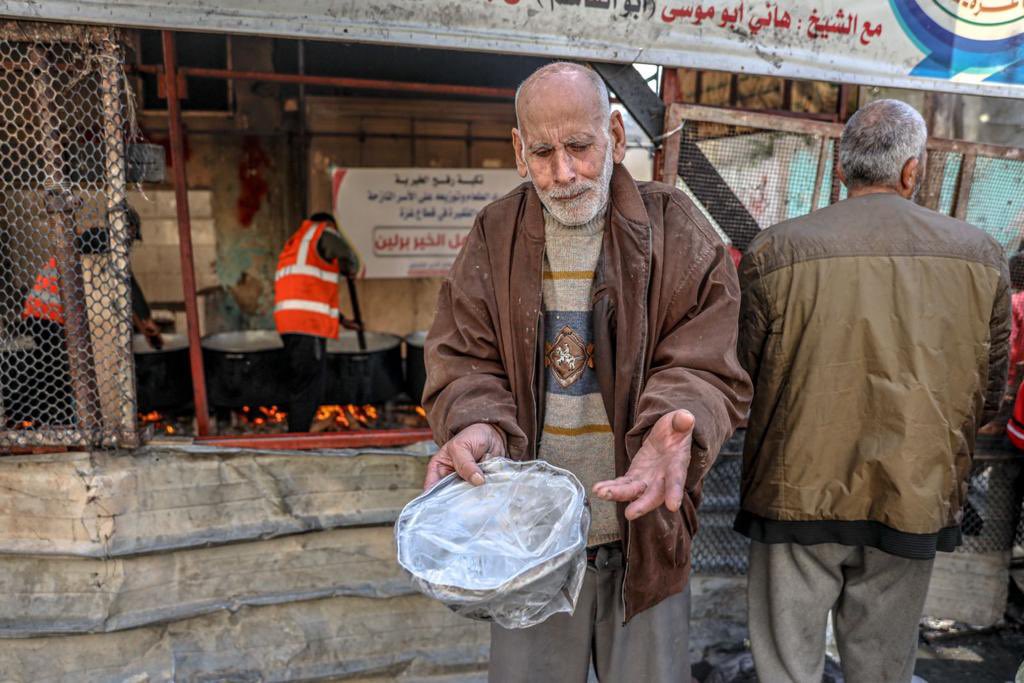A report produced by the UN, governments, and NGOs says that Gaza has reached the highest rating for food security, with one in four households suffering from starvation or acute malnutrition, while children are developing waterborne diseases.
The United Nations and Action Against Hunger among other organisations have declared “catastrophic hunger levels” in Gaza on Thursday following the 10-week brutal Israeli war on the besieged enclave.
In a UN-led report, the organisations said that Gaza has reached the highest rating for food security, known as Phase 5 or “catastrophe,” with one in four households suffering from starvation or acute malnutrition.
The NGOs used the declaration of famine in modern history four times, the first in Ethiopia in 1984, followed by North Korea in 1995, Somalia in 2011, and South Sudan in 2017.
“In Gaza, 2.3 million people, half of whom are children, are facing an escalated and potentially fatal risk of hunger,” the report warned, renewing calls for a ceasefire in the besieged coastal enclave.
The report added that four out of five households in northern Gaza and half of those displaced in the south would spend days “without eating a single thing.”
People would have to wait in long queues for hours to secure flour or rice and access enough water to maintain their hygiene.
“The combination of incessant shelling, shortages of food, water, fuel, and the inability of humanitarian agencies to fully operate in Gaza has caused this desperate situation,” Chiara Saccardi, Regional Head of Action Against Hunger in the Middle East, said in a press release.
Action Against Hunger added that Gaza is not receiving sufficient aid and the north cannot be reached due to the lack of transportation and ongoing fighting.
Israel has impeded aid access to northern Gaza since the start of its ground invasion of the area in November, which saw the forceful evacuation of thousands of patients and displaced Palestinians from the Al-Shifa Medical Complex.
On Monday, the UN Office for the Coordination of Humanitarian Affairs said that the food security in the north “is believed to be significantly worse” in comparison to other areas. There are 1.9 million people currently displaced in Gaza, making up around 90% of the entire population.
“The situation in Gaza has deteriorated to the point whereby protection actors are largely unable to operate, due to communication outages, risks in moving and access cut to northern Gaza,” the OCHA added.
Gaza’s collapsed medical sector has struggled to treat tens of thousands of injured Palestinians in the besieged enclave due to the significant shortage of resources under the complete Israeli blockade.
Additionally, the non-stop bombardment of Gaza by Israel and raids of medical facilities have all forced 23 out of 35 hospitals in the Strip to stop operating.
In the north, the Al-Ahli Arab Hospital is the only partially functional hospital and three others are minimally functional, according to the World Health Organization.
The three hospitals are Al-Shifa, Al Awda and Al Sahaba Medical Complex.
On 18 December, the Israeli occupation forces raided the vicinity of Al Awda Hospital in Jabalia, northern Gaza, OCHA reported. The Israeli forces captured males aged over 16 years old, including medical staff, patients and internally displaced persons during the raid.
Children are also developing waterborne diseases and lice due to the lack of basic hygiene and key items, including diapers and soap.
“Mothers are caring for their children with diarrhoea, sometimes with blood, but have no water, no wipes, and no nappies. People are angry, depressed, and desperate because of the situation they live in. They are very afraid,” Saccardi said.
Israel has continued its brutal genocidal war on Gaza for more than 10 weeks, killing more than 20,000 Palestinians, Palestine’s news agency said on Thursday.
Euro-Med reported on Tuesday that Israel killed 26,612 in Gaza, including 10,305 children and those who are presumed dead under the rubble.







